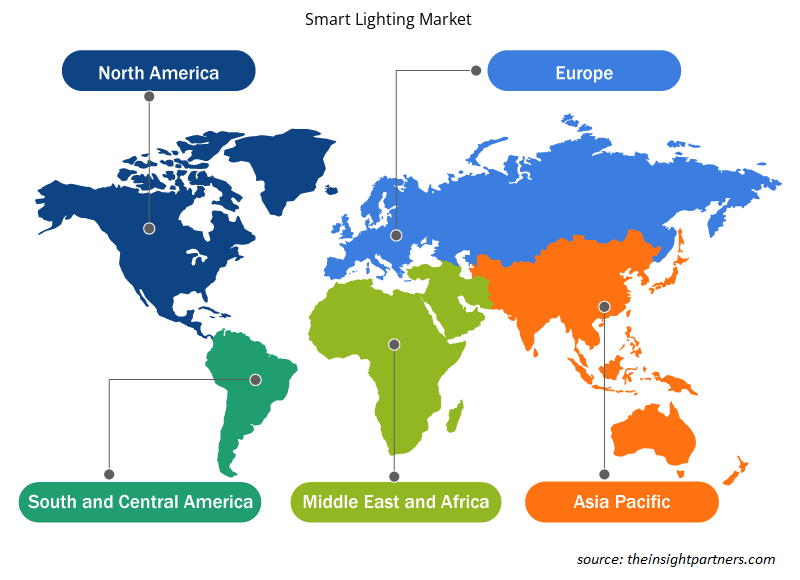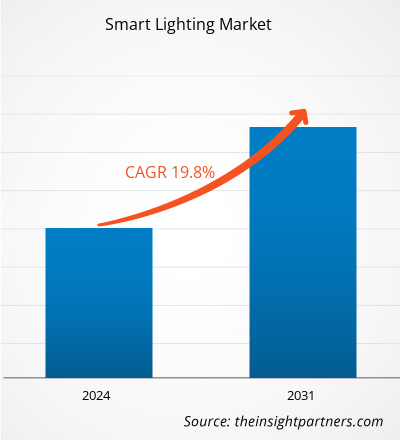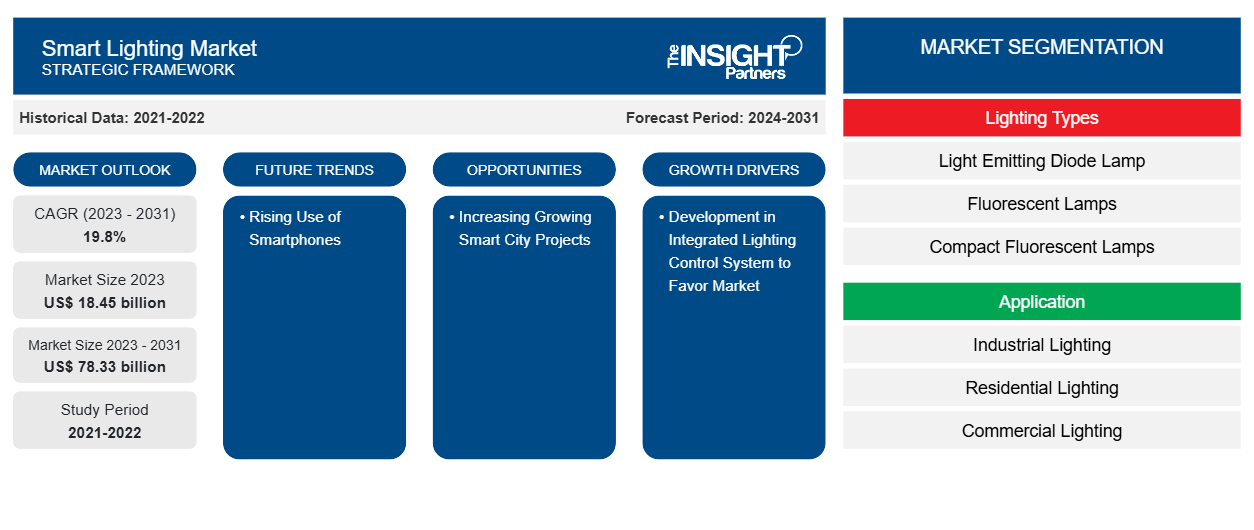Der Markt für intelligente Beleuchtung wird voraussichtlich von 18,45 Milliarden US-Dollar im Jahr 2023 auf 78,33 Milliarden US-Dollar im Jahr 2031 anwachsen. Der Markt wird voraussichtlich zwischen 2023 und 2031 eine durchschnittliche jährliche Wachstumsrate von 19,8 % verzeichnen. Die Entwicklung integrierter Lichtsteuerungssysteme und wachsende Smart-City-Projekte werden voraussichtlich weiterhin die wichtigsten Trends auf dem Markt für intelligente Beleuchtung bleiben.
Marktanalyse für intelligente Beleuchtung
Der Markt für intelligente Beleuchtung wächst rasant. In den letzten Jahren hat der Markt für intelligente Beleuchtung aufgrund der laufenden und bevorstehenden Smart-City-Projekte in Entwicklungsländern ein erhebliches Wachstum erfahren.
Marktübersicht für intelligente Beleuchtung
Leuchten sind sowohl in gewerblichen als auch in privaten Umgebungen beliebter und gefragter geworden, da sie sich mit IoT-Geräten verbinden lassen und mit einfachen Smartphones oder Tablets eine Reihe von Umgebungslicht erzeugen können. Bei Bedarf können intelligente Leuchten auf verschiedene Farbtöne gedimmt werden. Sie können auch über WLAN, Bluetooth, SmartThings, Z-Wave oder ZigBee verbunden und so programmiert werden, dass sie sich ein- oder ausschalten. Darüber hinaus kann die Sprachsteuerung von intelligenten Leuchten durch Plattformintegration wie Google Assistant, Microsoft Cortana, Apple Siri und Amazon Alexa erreicht werden. Neben der Beleuchtung umfassen diese umfangreichen Funktionssätze auch eine zunehmende Anzahl von IoT-Geräten und Smart-Assistant-Plattformen, die neue Wachstumschancen für den Markt für intelligente Beleuchtung eröffnet haben.
Passen Sie diesen Bericht Ihren Anforderungen an
Sie erhalten kostenlose Anpassungen an jedem Bericht, einschließlich Teilen dieses Berichts oder einer Analyse auf Länderebene, eines Excel-Datenpakets sowie tolle Angebote und Rabatte für Start-ups und Universitäten.
- Holen Sie sich die wichtigsten Markttrends aus diesem Bericht.Dieses KOSTENLOSE Beispiel umfasst eine Datenanalyse von Markttrends bis hin zu Schätzungen und Prognosen.
Treiber und Chancen auf dem Markt für intelligente Beleuchtung
Entwicklung eines integrierten Lichtsteuerungssystems begünstigt den Markt
Das Ein- und Ausschalten wird durch das integrierte Steuerungssystem von einem einzigen Standort aus ermöglicht. Die Kosteneffizienz intelligenter Beleuchtung und das gestiegene Bewusstsein der Verbraucher und der Regierung für die Notwendigkeit, Strom zu sparen, tragen zu ihrem wachsenden Marktanteil bei. Der Markt für intelligente Beleuchtung konnte aufgrund der Entwicklung integrierter Lichtsteuerungssysteme weltweit wachsen.
Zunehmendes Wachstum bei Smart City-Projekten
Da intelligente Beleuchtungsgeräte infolge laufender Smart-City-Projekte immer häufiger zum Einsatz kommen, wird erwartet, dass der weltweite Markt für intelligente Beleuchtung deutlich wachsen wird. Die Regierungen der Entwicklungsländer investieren massiv in die Schaffung intelligenter Städte. Für zahlreiche Anbieter in den Bereichen Beratung, Versorgungsleistungen und Informationstechnologie bietet dies eine erhebliche Geschäftschance. Da die optimale Nutzung des verfügbaren Stroms eines der Hauptziele der Entwicklung intelligenter Städte ist und intelligente Beleuchtung aufgrund ihrer Effizienz immer beliebter wird, passt intelligente Beleuchtung zu Smart-City-Projekten. Es wird prognostiziert, dass die Implementierung intelligenter Beleuchtung erheblich zu Energieeinsparungen und Nachhaltigkeit beitragen wird.
Segmentierungsanalyse des Marktberichts für intelligente Beleuchtung
Wichtige Segmente, die zur Ableitung der Marktanalyse für intelligente Beleuchtung beigetragen haben, sind Beleuchtungsarten, Anwendungen und Konnektivitätstechnologie.
- Basierend auf Beleuchtungsarten ist der Markt für intelligente Beleuchtung in Leuchtdiodenlampen (LED), Leuchtstofflampen, Kompaktleuchtstofflampen (CFL), Hochdruckentladungslampen und andere (Neonlampen und Fotoblitze) unterteilt. Das LED-Segment hatte im Jahr 2023 einen größeren Marktanteil.CFL), high-intensity discharge lamps, and others (neon lamps and photographic flashes). The LED segment held a larger market share in 2023.
- Nach Anwendungsgröße ist der Markt in Industriebeleuchtung, Wohnbeleuchtung, Gewerbebeleuchtung, Regierungsbeleuchtung, Außenbeleuchtung und Automobilbeleuchtung segmentiert . Das Wohnsegment hatte im Jahr 2023 den größten Marktanteil.
- Basierend auf der Konnektivitätstechnologie ist der Markt für intelligente Beleuchtung in kabelgebundene und kabellose unterteilt. Das kabellose Segment hatte im Jahr 2023 einen größeren Marktanteil.
Marktanteilsanalyse für intelligente Beleuchtung nach geografischer Lage
Der geografische Umfang des Smart Lighting-Marktberichts ist hauptsächlich in fünf Regionen unterteilt: Nordamerika, Asien-Pazifik, Europa, Naher Osten und Afrika sowie Südamerika/Süd- und Mittelamerika. Nordamerika hat den Smart Lighting-Markt dominiert. Trends zur Einführung hoher Technologien in verschiedenen Branchen der Region haben das Wachstum des Smart Lighting-Marktes vorangetrieben. Faktoren wie die zunehmende Einführung digitaler Tools und hohe Technologieausgaben von Regierungsbehörden dürften das Wachstum des nordamerikanischen Smart Lighting-Marktes vorantreiben. Darüber hinaus zwingt eine starke Betonung von Forschung und Entwicklung in den entwickelten Volkswirtschaften nordamerikanische Akteure dazu, technologisch fortschrittliche Lösungen auf den Markt zu bringen. All diese Faktoren tragen zum Wachstum des Smart Lighting-Marktes in der Region bei.
Regionale Einblicke in den Markt für intelligente Beleuchtung
Die regionalen Trends und Faktoren, die den Smart Lighting-Markt im Prognosezeitraum beeinflussen, wurden von den Analysten von Insight Partners ausführlich erläutert. In diesem Abschnitt werden auch die Marktsegmente und die Geografie des Smart Lighting-Marktes in Nordamerika, Europa, im asiatisch-pazifischen Raum, im Nahen Osten und Afrika sowie in Süd- und Mittelamerika erörtert.

- Erhalten Sie regionale Daten zum Markt für intelligente Beleuchtung
Umfang des Marktberichts für intelligente Beleuchtung
| Berichtsattribut | Details |
|---|---|
| Marktgröße im Jahr 2023 | 18,45 Milliarden US-Dollar |
| Marktgröße bis 2031 | 78,33 Milliarden US-Dollar |
| Globale CAGR (2023 - 2031) | 19,8 % |
| Historische Daten | 2021-2022 |
| Prognosezeitraum | 2024–2031 |
| Abgedeckte Segmente | Nach Beleuchtungsarten
|
| Abgedeckte Regionen und Länder | Nordamerika
|
| Marktführer und wichtige Unternehmensprofile |
|
Dichte der Marktteilnehmer für intelligente Beleuchtung: Die Auswirkungen auf die Geschäftsdynamik verstehen
Der Markt für intelligente Beleuchtung wächst rasant. Dies wird durch die steigende Nachfrage der Endnutzer aufgrund von Faktoren wie sich entwickelnden Verbraucherpräferenzen, technologischen Fortschritten und einem größeren Bewusstsein für die Vorteile des Produkts vorangetrieben. Mit der steigenden Nachfrage erweitern Unternehmen ihr Angebot, entwickeln Innovationen, um die Bedürfnisse der Verbraucher zu erfüllen, und nutzen neue Trends, was das Marktwachstum weiter ankurbelt.
Die Marktteilnehmerdichte bezieht sich auf die Verteilung von Firmen oder Unternehmen, die in einem bestimmten Markt oder einer bestimmten Branche tätig sind. Sie gibt an, wie viele Wettbewerber (Marktteilnehmer) in einem bestimmten Marktraum im Verhältnis zu seiner Größe oder seinem gesamten Marktwert präsent sind.
Die wichtigsten auf dem Markt für intelligente Beleuchtung tätigen Unternehmen sind:
- Signify Holding
- Legrand North America, LLC
- Gesellschaften, beginnend mit ACUITY
- Lutron Electronics Co., Inc
- Leviton Manufacturing Co., Inc
- Zumtobel
Haftungsausschluss : Die oben aufgeführten Unternehmen sind nicht in einer bestimmten Reihenfolge aufgeführt.

- Überblick über die wichtigsten Akteure auf dem Markt für intelligente Beleuchtung
Neuigkeiten und aktuelle Entwicklungen zum Markt für intelligente Beleuchtung
Der Markt für intelligente Beleuchtung wird durch die Erfassung qualitativer und quantitativer Daten nach Primär- und Sekundärforschung bewertet, die wichtige Unternehmensveröffentlichungen, Verbandsdaten und Datenbanken umfasst. Im Folgenden finden Sie eine Liste der Entwicklungen auf dem Markt:
- Im Februar 2023 lieferte Signify, einer der weltweit führenden Anbieter von Beleuchtungslösungen, LED-Straßenbeleuchtung, intelligente Masten und ein vernetztes Beleuchtungssystem an die Industrieparks in der Stadt Huanggang in der chinesischen Provinz Hubei. Dieses groß angelegte Smart-Pole-Projekt wird es der Provinz ermöglichen, Energiekosten und Emissionen zu sparen und gleichzeitig die städtische Infrastruktur zu digitalisieren.
(Quelle: Signify, Pressemitteilung, 2023)
- Um eine bessere nahtlose Verknüpfung mit der Smart-IoT-Plattform zu ermöglichen und den Benutzern eine bequemere intelligente Interaktion zu bieten, hat Yeelight als führender Lösungsanbieter im Bereich intelligente Beleuchtung im November 2023 offiziell eine aktualisierte Lösung auf Basis der nahtlosen Einrichtung des BLE Mesh-Protokolls für Hersteller und Marken eingeführt.
(Quelle: Yeelight, Pressemitteilung, 2023)
Marktbericht zu intelligenter Beleuchtung – Abdeckung und Ergebnisse
Der Bericht „Marktgröße und Prognose für intelligente Beleuchtung (2021–2031)“ bietet eine detaillierte Analyse des Marktes, die die folgenden Bereiche abdeckt:
- Marktgröße und Prognose auf globaler, regionaler und Länderebene für alle abgedeckten wichtigen Marktsegmente.
- Marktdynamik wie Treiber, Beschränkungen und wichtige Chancen
- Wichtige Zukunftstrends
- Detaillierte PEST/Porters Five Forces- und SWOT-Analyse
- Globale und regionale Marktanalyse, die wichtige Markttrends, wichtige Akteure, Vorschriften und aktuelle Marktentwicklungen abdeckt.
- Branchenlandschaft und Wettbewerbsanalyse, einschließlich Marktkonzentration, Heatmap-Analyse, prominenten Akteuren und aktuellen Entwicklungen.
- Detaillierte Firmenprofile
- Historische Analyse (2 Jahre), Basisjahr, Prognose (7 Jahre) mit CAGR
- PEST- und SWOT-Analyse
- Marktgröße Wert/Volumen – Global, Regional, Land
- Branchen- und Wettbewerbslandschaft
- Excel-Datensatz
Aktuelle Berichte
Erfahrungsberichte
Grund zum Kauf
- Fundierte Entscheidungsfindung
- Marktdynamik verstehen
- Wettbewerbsanalyse
- Kundeneinblicke
- Marktprognosen
- Risikominimierung
- Strategische Planung
- Investitionsbegründung
- Identifizierung neuer Märkte
- Verbesserung von Marketingstrategien
- Steigerung der Betriebseffizienz
- Anpassung an regulatorische Trends





















 Kostenlose Probe anfordern für - Markt für intelligente Beleuchtung
Kostenlose Probe anfordern für - Markt für intelligente Beleuchtung